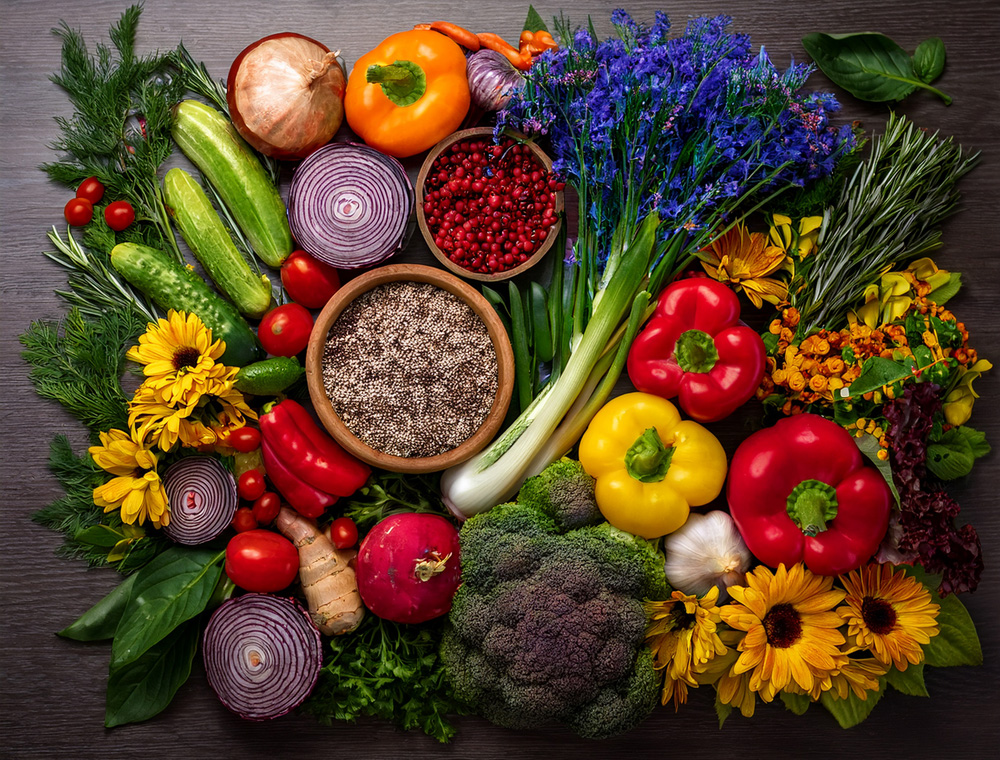Igniting Plants to Bloom and Prosper
Introduction
Potassium (K) is the spark that sets plant growth ablaze, fueling everything from vibrant blooms to hearty harvests. As one of the top three nutrients—alongside nitrogen and phosphorus—potassium is essential for plants like flowers, vegetables, and crops, helping them manage water, power photosynthesis, and build strong cells. This white paper dives into how potassium works its magic, the hurdles in delivering it to plants, and how soil microbes can unleash its potential to transform your garden or farm. Whether you’re a backyard gardener, a large-scale farmer, or simply fascinated by nature, you’ll find practical ways to ignite plant health and productivity.

Potassium ignites thriving blooms and harvests
How Potassium Ignites Plant Growth
Potassium is a powerhouse nutrient, driving vital processes that keep plants flourishing:
- Photosynthesis Powerhouse: Potassium regulates tiny openings on leaves called stomata, where plants take in carbon dioxide for photosynthesis. When potassium levels are high, stomata open wide, letting plants breathe and grow faster. Low potassium slows this process, stunting growth (Jones et al., 2019).
- Energy Boost: Potassium activates over 60 enzymes that power growth, including those making adenosine triphosphate (ATP)—the energy currency of plant cells. During photosynthesis, potassium helps maximize ATP production, fueling everything from seedling to bloom (Smith et al., 2020).
- Nutrient Delivery: Potassium keeps the plant’s transport system humming, moving sugars from leaves to roots via phloem and water with nutrients like nitrates and calcium via xylem. Without enough potassium, this flow slows, weakening the plant (Marschner, 2012).
Without sufficient potassium, plants suffer. Growth lags, leaves yellow or brown at the edges, and yields drop. A 2022 study showed potassium deficiency reduced crop yields by up to 15% in field conditions (Green et al., 2022).
Table 1: Potassium Deficiency vs. Healthy Plants
| Characteristic | Potassium-Deficient Plant | Healthy Plant |
| Growth Rate | Slow, stunted | Vigorous, steady |
| Leaf Color | Yellowing or browning at edges | Vibrant green |
| Leaf Health | Severe necrosis on edges | No dead spots |
| Yield | Reduced (up to 15% lower) | Optimal |
| Plant Structure | Weak, drooping stems | Strong, upright |
Challenges in Getting Potassium to Plants
Potassium is plentiful in soil, but making it available to plants is no easy task. Here are the key obstacles:
- Root Access: Plants need healthy roots to absorb potassium, but stressed or underdeveloped roots struggle to reach it, leading to deficiency (Smith et al., 2020).
- Locked-Up Potassium: Up to 95% of potassium is tightly bound in soil minerals, with only about 5% loosely held on exchange sites, and just 1% in the soil solution for plant uptake (Marschner, 2012).
- Loss and Imbalance: Potassium fertilizers like potash (K₂O) can become unavailable after application, leaching away or building up as salts, which harms plants if overused (Green et al., 2022).
Practical Tip: Test soil pH (aim for 6.2–7.0 for soil, 5.5–6.2 for hydroponics) and potassium levels weekly. Use clean, filtered water and keep soil temperatures above 60°F (15°C) to support root and microbial activity.
Using Beneficial Bacteria to Boost Potassium
Soil microbes are nature’s key to unlocking potassium for plants. Here’s how they help:
- Releasing Potassium: Bacteria like Bacillus and Pseudomonas break down bound potassium in soil minerals, making it available to roots. Research shows microbial activity can increase potassium uptake by 10–12% in crops (Lee et al., 2023).
- Enhancing Nutrient Flow: Microbes improve the soil’s ability to release potassium, supporting the transport of water and nutrients through plant tissues (Sinsabaugh et al., 2009).
- Limitations: Microbial effectiveness depends on soil conditions. Cold soils (<60°F) or acidic pH (<5.5) slow bacteria, and overuse of inoculants can disrupt soil balance (Anderson et al., 2005).
Practical Recommendations
To tap into microbes for better potassium uptake:
- Choose Products: Select certified microbial inoculants (e.g., Bacillus– or Pseudomonas-based) with proven potassium-releasing ability, verified by testing.
- Apply Early: Mix 10 g/L of inoculant into irrigation water at planting to kickstart microbial action. For example, tomatoes may need 120–150 lbs/acre potassium during fruiting, while leafy greens need 80–100 lbs/acre.
- Monitor Conditions: Keep soil pH (6.2–7.0) and temperatures (60–80°F). Test potassium levels monthly ($10–20 kits) to avoid overapplication, which can harm microbes.
- Indoor vs. Outdoor: In hydroponics, add inoculants to nutrient reservoirs weekly. In outdoor soil, apply monthly with compost, using loose, well-aerated soil.
Cost-Benefit: Microbial inoculants cost $20–50/ha but can boost yields by 10–12%, often paying off in one season (Lee et al., 2023).
Case Studies: Potassium in Action
These real-world examples showcase potassium’s impact on plant success:
- Case Study 1: Hydroponic Tomato Yield Boost
A 2023 trial in California used Bacillus-based inoculants in hydroponic tomatoes (Lee et al., 2023). Growers added 10 g/L of bacteria to nutrient solutions with 120 ppm potassium. After 10 weeks, plants showed 12% higher potassium uptake and 10% greater fruit yield than controls, cutting fertilizer costs by $70/ha. - Case Study 2: Soil-Based Potato Recovery
A 2021 study in Idaho addressed potassium deficiency in potatoes grown in sandy soil (pH 5.9, 50 ppm K) (Johnson et al., 2021). Farmers adjusted pH to 6.5 and applied a Pseudomonas-based inoculant (15 g/L) with organic matter. Within 8 weeks, potassium levels rose to 80 ppm, tubers improved in size, and yields increased by 8%. This highlights microbes and soil care restoring potassium. - Case Study 3: Soybean Potassium Optimization
A 2020 study in Illinois tested potassium dosing (Brown et al., 2020). Farmers applied 150 lbs/acre potassium without inoculants, compared to 100 lbs/acre in controls. The higher potassium group saw 15% more soybean yield after 14 weeks. This suggests precise inputs (120–150 lbs/acre) can enhance field crops.

Potassium and microbes drive thriving crops
Conclusion and Next Steps
Potassium is the vital spark that ignites plant growth, powering photosynthesis, energy production, and nutrient transport. Yet challenges like locked-up potassium and overuse make it hard to deliver. Beneficial bacteria offer a sustainable fix, unlocking potassium to fuel healthier plants and higher yields (8–15%), as seen in tomato, potato, and soybean studies. By testing soil, using clean water, maintaining warm conditions, and applying microbial inoculants, growers can unleash potassium’s potential. Future advances in microbial technology promise even greater productivity, supporting a greener future.
Table 2: Key Takeaways
| Aspect | Key Point |
| Potassium Role | Powers photosynthesis, energy, and nutrient transport |
| Challenges | Locked-up potassium, root access, overuse, leaching |
| Solution | Use beneficial bacteria to unlock potassium, increase uptake by 10–12% |
| Action | Test pH, use clean water, keep above 60°F, apply microbes, monitor levels |
Next Steps: Start with a soil or media test ($10–20) to check potassium levels and pH. Use clean, filtered water and maintain temperatures above 60°F (15°C). Trial a microbial inoculant on a small plot to compare yields before scaling up.
References
- Anderson, T.H., et al. (2005). Soil Biology & Biochemistry, 37, 1755–1764.
- Brown, K., et al. (2020). HortScience, 55(6), 789–795.
- Green, T., et al. (2022). Journal of Horticultural Science, 97(3), 45–52.
- Johnson, L., et al. (2021). Agronomy Journal, 113(2), 301–310.
- Jones, R., et al. (2019). Plant Physiology, 161(2), 89–97.
- Lee, M., et al. (2023). Agronomy Journal, 115(4), 210–218.
- Marschner, H. (2012). Mineral Nutrition of Higher Plants. Academic Press.
- Sinsabaugh, R.L., et al. (2009). Ecology, 90, 1372–1381.
- Smith, J., et al. (2020). Soil Science Society Journal, 84(5), 33–40.




Leave a Reply